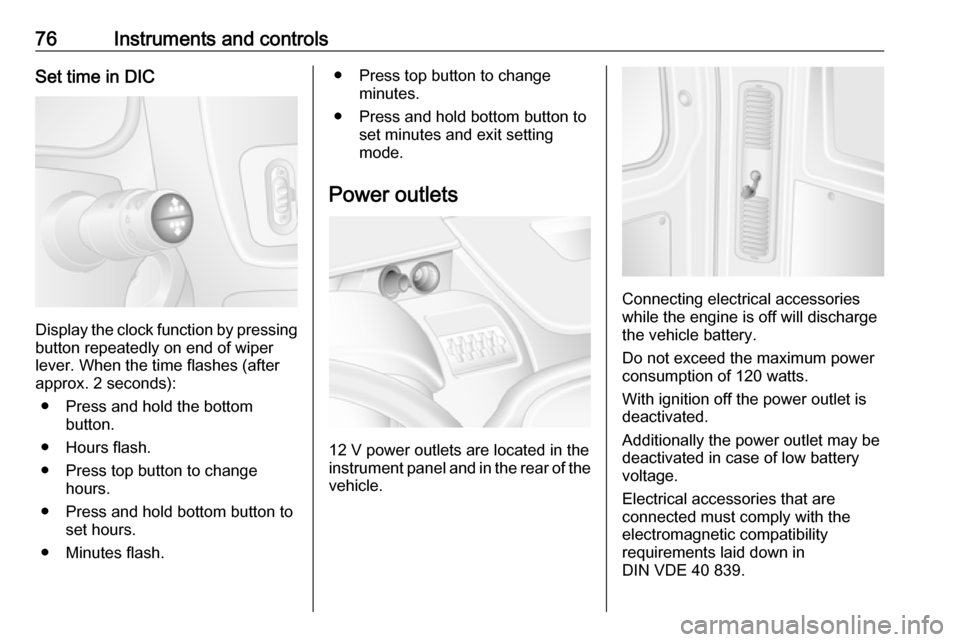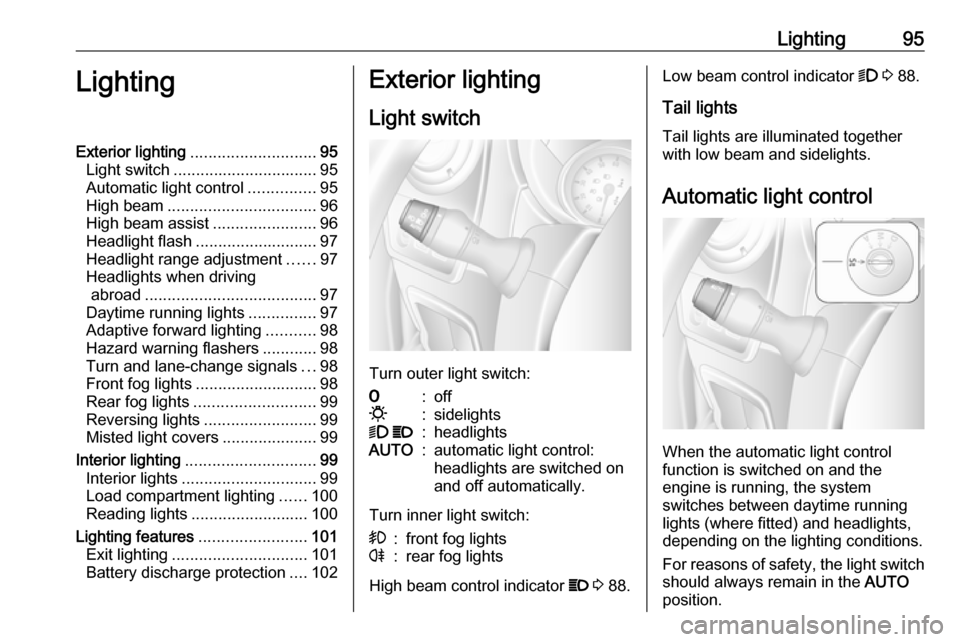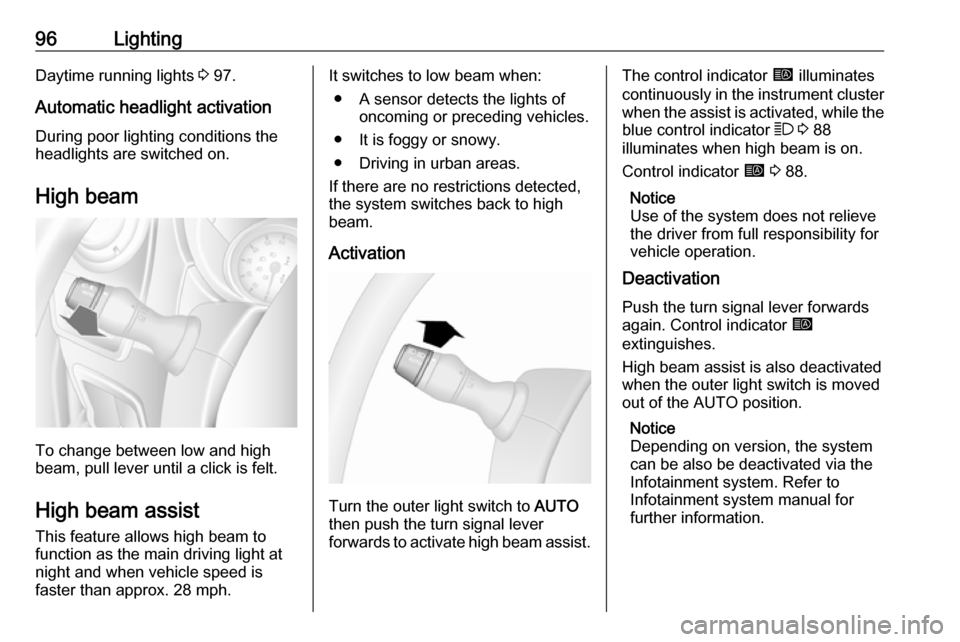2016 VAUXHALL MOVANO_B change time
[x] Cancel search: change timePage 33 of 233

Keys, doors and windows31Activation
Press e twice within 3 seconds.
Hazard warning lights flash
five times as confirmation.
Deactivation Unlock the doors by pressing c on the
remote control.
Anti-theft alarm system The anti-theft alarm system is
operated in conjunction with the
central locking system.
It monitors:
● doors, tailgate, bonnet
● passenger compartment
● load compartment
● ignition
● interruption of alarm siren power supply
Activation
All doors and the bonnet must be
closed.
Press e to activate anti-theft alarm
system. Hazard warning lights flash
twice to confirm activation.
If the hazard warning lights do not
flash upon activation, a door or the
bonnet is not fully closed.
Notice
Changes to the vehicle interior, e.g.
the use of seat covers, and open
windows, could impair the function
of passenger compartment
monitoring.
Deactivation
Unlocking the vehicle or switching on the ignition deactivates the anti-theft
alarm system. Hazard warning lights
flash once to confirm deactivation.
Notice
If the alarm has been triggered,
unlocking the vehicle with the key
will not stop the alarm siren. To stop the siren, switch on the ignition. The
hazard warning lights will not flash
upon deactivation if the alarm has
been triggered.
Activation without monitoring of
passenger compartment
Switch off monitoring of the
passenger compartment when
people or animals are being left in the
Page 78 of 233

76Instruments and controlsSet time in DIC
Display the clock function by pressingbutton repeatedly on end of wiper
lever. When the time flashes (after
approx. 2 seconds):
● Press and hold the bottom button.
● Hours flash.
● Press top button to change hours.
● Press and hold bottom button to set hours.
● Minutes flash.
● Press top button to change minutes.
● Press and hold bottom button to set minutes and exit setting
mode.
Power outlets
12 V power outlets are located in the instrument panel and in the rear of the
vehicle.
Connecting electrical accessories
while the engine is off will discharge
the vehicle battery.
Do not exceed the maximum power consumption of 120 watts.
With ignition off the power outlet is deactivated.
Additionally the power outlet may be
deactivated in case of low battery
voltage.
Electrical accessories that are
connected must comply with the
electromagnetic compatibility
requirements laid down in
DIN VDE 40 839.
Page 93 of 233

Instruments and controls91Tyre pressure monitoring system
3 177.
Warning chimes
When starting the engine or whilst driving
Only one warning chime will sound at
a time.
The warning chime regarding
unfastened seat belts has priority
over any other warning chime.
● If seat belt is not fastened 3 47.
● If a certain speed is exceeded with the parking brake applied
3 135.
● If the parking assist detects an object or a fault is present
3 142.
● If the vehicle has manual transmission automated and the
clutch temperature is too high 3 130.
● If the vehicle speed briefly exceeds a set limit 3 77.
● During closing of the power sliding door 3 26.● If the sliding door is open and the
parking brake is released 3 26.
● During activation and deactivation of alarm monitoring
of vehicle inclination 3 31.
● If the AdBlue level falls below a certain amount or a fault is
present 3 125.
● If the lane departure warning system detects an unintended
lane change and when the
system is activated 3 146.
When the vehicle is parked and/or the driver's door is opened
● When the key is in the ignition switch.
● With exterior lights on.
● If the vehicle has manual transmission automated 3 130;
the parking brake has not been
applied, neutral is not selected or the brake pedal has not been
depressed. A corresponding
message may also appear in the
Driver Information Centre (DIC)
3 89.● If the sliding side door exterior
handle is in the open position
when unlocking the vehicle 3 26.
● If the engine is in an Autostop but
not switched off. Stop-start
system 3 119.
Page 97 of 233

Lighting95LightingExterior lighting............................ 95
Light switch ................................ 95
Automatic light control ...............95
High beam ................................. 96
High beam assist .......................96
Headlight flash ........................... 97
Headlight range adjustment ......97
Headlights when driving abroad ...................................... 97
Daytime running lights ...............97
Adaptive forward lighting ...........98
Hazard warning flashers ............98
Turn and lane-change signals ...98
Front fog lights ........................... 98
Rear fog lights ........................... 99
Reversing lights .........................99
Misted light covers .....................99
Interior lighting ............................. 99
Interior lights .............................. 99
Load compartment lighting ......100
Reading lights .......................... 100
Lighting features ........................101
Exit lighting .............................. 101
Battery discharge protection ....102Exterior lighting
Light switch
Turn outer light switch:
7:off0:sidelights9 P:headlightsAUTO:automatic light control:
headlights are switched on
and off automatically.
Turn inner light switch:
>:front fog lightsr:rear fog lights
High beam control indicator P 3 88.
Low beam control indicator 9 3 88.
Tail lights Tail lights are illuminated together
with low beam and sidelights.
Automatic light control
When the automatic light control
function is switched on and the
engine is running, the system
switches between daytime running
lights (where fitted) and headlights,
depending on the lighting conditions.
For reasons of safety, the light switch
should always remain in the AUTO
position.
Page 98 of 233

96LightingDaytime running lights 3 97.
Automatic headlight activation
During poor lighting conditions the
headlights are switched on.
High beam
To change between low and high
beam, pull lever until a click is felt.
High beam assist This feature allows high beam to
function as the main driving light at
night and when vehicle speed is
faster than approx. 28 mph.
It switches to low beam when:
● A sensor detects the lights of oncoming or preceding vehicles.
● It is foggy or snowy.
● Driving in urban areas.
If there are no restrictions detected, the system switches back to high
beam.
Activation
Turn the outer light switch to AUTO
then push the turn signal lever
forwards to activate high beam assist.
The control indicator í illuminates
continuously in the instrument cluster when the assist is activated, while the
blue control indicator 7 3 88
illuminates when high beam is on.
Control indicator í 3 88.
Notice
Use of the system does not relieve
the driver from full responsibility for
vehicle operation.
Deactivation
Push the turn signal lever forwards
again. Control indicator í
extinguishes.
High beam assist is also deactivated when the outer light switch is moved
out of the AUTO position.
Notice
Depending on version, the system
can be also be deactivated via the
Infotainment system. Refer to
Infotainment system manual for
further information.
Page 109 of 233

Climate control107If no cooling or drying is required
press AC OFF to switch the cooling
system off, thus saving fuel.
" AC OFF " appears in the display.
Manual air recirculation mode Press u. LED illuminates and u
appears in the display.9 Warning
The exchange of fresh air is
reduced in air recirculation mode.
In operation without cooling the air humidity increases, so the
windows may mist up. The quality
of the passenger compartment air
deteriorates, which may cause the vehicle occupants to feel drowsy.
To return to automatic mode: press
u or AUTO .
Rear heating system
If the engine is switched off, the rear
compartment can be heated by the
additional heating, through low level
vents.
By programming values using the
control panel, the user can adjust the
time, day and temperature settings.
Heating will cease to operate if the
vehicle fuel level drops too low.
During operation, power from the
vehicle battery is used. For short
journey times, check the vehicle
battery regularly and recharge if
necessary.
To ensure efficient performance, the
low level air vents in the rear
passenger compartment must not be
obstructed.9 Warning
Do not operate the system when
refuelling, when dust or
combustible vapours are present
or in enclosed spaces (e.g.
garage).
Setting the time and day
Press Ö until the time display flashes.
If the vehicle battery supply has been
interrupted prior to its use, press m
or n briefly to make the time display
flash.
Adjust the time by pressing m or n .
The time is set when the displayed
time stops flashing.
The display for the day will then flash: adjust the day by pressing m or n .
The day is set when the display stops
flashing.
Page 112 of 233

110Climate controlTimer1 X:switches the control unit
on/off and changes
displayed information2 q
back:selects functions in the
menu bar and adjusts
values3 menu
bar:displays the selectable
functions Y, x , P , Ö and
Y4 r next:selects functions in the
menu bar and adjusts
values5 OK:confirms selectionRemote control
The control buttons operate
identically to the timer unit described
previously.
To activate the remote control, press X and release it when the menu bar
appears in the display. The signal
indicator and SENd appear briefly in
the display, followed by the
temperature.
9 Warning
When refuelling, switch off the
remote control unit as well as the
heater!
To switch off, press and hold X to
prevent inadvertent operation.
The remote control has a maximum
range of 600 metres. The range may
be reduced due to environmental
conditions and as the battery
becomes weaker.
In addition to the remote control unit,
the heating can also be switched on
for 30 minutes, or off, using the button
on the instrument panel.
Battery replacement
Replace the battery when the range
of the remote control is reduced or when the battery charge symbol
flashes.
Page 113 of 233

Climate control111Open the cover using a coin and
replace the battery (CR 2430 or
equivalent), ensuring the new battery
is correctly installed with the positive
( < ) side facing the positive terminals.
Replace the cover securely.
Dispose of old batteries in
accordance with environmental
regulations.
Batteries do not belong in household
waste. They must be disposed of at
an appropriate recycling collection
point.
Remote control fault displays
cobA:poor signal –
adjust positionconP:no signal – move closerbALo:battery low –
change batteryErr:system error –
consult workshopAdd,
AddE:system in learning mode
Teach remote control
If the vehicle battery is reconnected,
the LED in the instrument panel
button illuminates and the system
configures the remote control menu
automatically. If the LED flashes,
press OK on remote control, select
Add or AddE and confirm.
Additional remote control units may
also be configured. Press the button
until LED flashes, switch on the
remote control, select Add and
confirm.
AddE teaches the current remote
control unit exclusively and blocks all
previously configured units. Add
teaches up to 4 remote control units,
but only one unit can operate the
system at any one time.
Operation
Heating Y
Select Y in the menu bar and confirm.
The predetermined heating duration,
e.g. L 30, flashes in the display. The
factory setting is 30 minutes.
To temporarily adjust the heating
duration, adjust with q or r and
confirm. The value can be set from 10 to 120 minutes. Due to the power
consumption, note the heating
duration.
To switch off, select Y in the menu bar
again and confirm.
Ventilation x
Select x in the menu bar and confirm.
The ventilation duration can be
accepted or adjusted. The duration
shown is accepted without
confirmation.
To switch off, select x in the menu bar
again and confirm.
Programming P
Up to 3 preset departure times can be programmed, either during one day or
over one week.